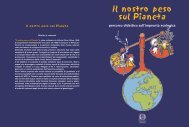Myanmar Protected Areas: Context, Current Status ... - Istituto Oikos
Myanmar Protected Areas: Context, Current Status ... - Istituto Oikos
Myanmar Protected Areas: Context, Current Status ... - Istituto Oikos
You also want an ePaper? Increase the reach of your titles
YUMPU automatically turns print PDFs into web optimized ePapers that Google loves.
Several bird surveys were carried out in different years and periods of the year, first under the MABR<br />
project (2006-2009) and then in the framework of the MEP project (2009-2010).<br />
Beach Thicknee in Lampi Island MNP (A. Bonetti)<br />
Table 10 Threatened and near threatened birds of Lampi Island MNP<br />
A total of 228 species were observed in Lampi<br />
Island Marine National Park and surrounding<br />
areas. Out of these, 8 species are new records<br />
for <strong>Myanmar</strong>: Malaysian Plover (Charadrius<br />
peronii), Bar-tailed Godwit (Limosa lapponica),<br />
Common Tern (Sterna hirundo), Rusty-breasted<br />
Cuckoo (Cacomantis sepulcralis), Short-tailed<br />
Babbler (Malacocincla malaccensis), Little<br />
Curlew (Numenius minitus), Grey-chested Jungle<br />
Flycatcher (Rhinomyias umbratilis), Golden-bellied<br />
Gerygone (Gerygone sulphurea). 19 species are<br />
listed as threatened and near threatened in the<br />
IUCN Red List of Threatened Species.<br />
Scientific name Common name <strong>Status</strong> (Red List 2010)<br />
Aceros subruficollis Plain-pouched Hornbill VU<br />
Spizaetus nanus Wallace’s Hawk Eagle VU<br />
Rollulus rouloul Crested Partridge NT<br />
Caloperdix oculea Ferruginous Partridge NT<br />
Megalaima mystacophanos Red-throated Barbet NT<br />
Buceros bicornis Great Hornbill NT<br />
Halcyon amauroptera Brown-winged Kingfisher NT<br />
Phaenicophaeus diardi Black-bellied Malkoha NT<br />
Treron fulvicollis Cinnamon-headed Green Pigeon NT<br />
Numenius arquata Eurasian Curlew NT<br />
Esacus neglectus Beach Thicknee NT<br />
Ichthyophaga ichthyaetus Grey-headed Fish Eagle NT<br />
Pitta megarhyncha Mangrove Pitta NT<br />
Pericrocotus igneus Fiery Minivet NT<br />
Aegithina viridissima Green Lora NT<br />
Rhinomyias umbratilis Gray-chested Jungle Flycatcher NT<br />
Anthreptes rhodolaema Red-throated Sunbird NT<br />
Charadrius peronii Malaysian Plover NT<br />
Platysmurus leucopterus Black Magpie NT<br />
VU=Vulnerable; NT=Near Threatened<br />
Additional surveys in different periods of the year are needed as well as specific studies on population<br />
densities and dynamics for species of conservation concern like the vulnerable Plain-pouched Hornbill<br />
(see Box 1) and Wallace’s Hawk Eagle.<br />
The assessment survey on mammals recorded 19 species of small, medium and large size mammal.<br />
Out of these, 7 species are in danger according to the IUCN Red List of Threatened Species (2010).<br />
Table 11 Threatened and near threatened mammals of Lampi Island MNP<br />
Scientific name Common name <strong>Status</strong> (IUCN Red List 2010)<br />
Elephas maximus Asian Elephant EN<br />
Sunda pangolin Sunda Pangolin EN<br />
Dugong dugon Dugong VU<br />
Macaca nemestrina Southern Pig-tailed Macaque VU<br />
Aonyx cinerea Oriental Small-clawed Otter VU<br />
Ratufa bicolor Black Giant Squirrel NT<br />
Trachypithecus obscurus Dusky Langur NT<br />
EN=Endangered; VU=Vulnerable; NT=Near Threatened<br />
The Lesser Mouse-deer can be considered abundant on Lampi Island since it is very common to find<br />
traces of this animal in the forest, but the high incidence of illegal hunting reported by the villagers<br />
and directly observed by the project team, poses serious concern about the long term survival of the<br />
population of Lesser Mouse-deer in Lampi. The Lesser Mouse-deer found in Lampi is considered a<br />
subspecies (Tragulus kanchil subsp. lampensis) although further investigation is required to confirm it. 11<br />
A large colony of island flying foxes Pteropus hypomelanus, between 3500-4000 individuals, was recorded<br />
(MABR, MEP) on the small island of Than dar Ni Island in the Gregory Group, although in 2010 only few<br />
individuals were observed. The Dugong (Dugong dugon) occurs in the area since feeding trails were<br />
observed several times starting from 2008, on a dense seagrass meadow in the east coast of Lampi<br />
Island, where Halophila ovalis is the dominant seagrass species (one of the dugong’s favourite seagrass<br />
species). Occurrence of dugong at some islands of Myeik Archipelago such as Sular Island, La Ngan<br />
Island, Bo Lut Island and War Kyunn Island was also reported by local people. The feeding trails found in<br />
Lampi constitute the first proof of the occurrence of the dugong in the Myeik Archipelago.<br />
Mammal species mentioned by the FAO report (1983) and in the notification letter for the establishment<br />
of Lampi Island MNP, like the Barking Deer (Muntiacus muntjak), the capped Langur (Trachypithecus<br />
pileatus) and the White-handed Gibbon (Hylobates lar), were not found during the current surveys and<br />
nor had they been observed by local people.<br />
Threats<br />
Lampi Island Marine National Park has total protection, but its status until now of paper park, with no staff<br />
and infrastructure, has caused an increasing development of illegal human activities and settlements.<br />
The main island of Lampi is the only one where also local people have the perception that activities<br />
conducted there are in a sort of illegality framework, while on the minor islands, although part of the<br />
marine NP, there is an unwritten consensus about the possibility to exercise different types of activity and<br />
to establish temporary or even permanent settlements. Therefore the MNP is coming under increasing<br />
threat from settlements and human activities even within the park’s boundaries. As human population<br />
increases in its immediate vicinity, there is a corresponding increase in the use of natural resources also<br />
inside the protected area to satisfy human needs. The main threats recorded by the project in the area<br />
can be classified as follows, according to the IUCN and the Conservation Measures Partnership (CMP)<br />
classification of threats:<br />
11 For a discussion on mouse-deer systematics, see Miller (1903) and Meijaard & Groves (2004).<br />
In-depth Study of Lampi Island Marine National Park<br />
110 111






